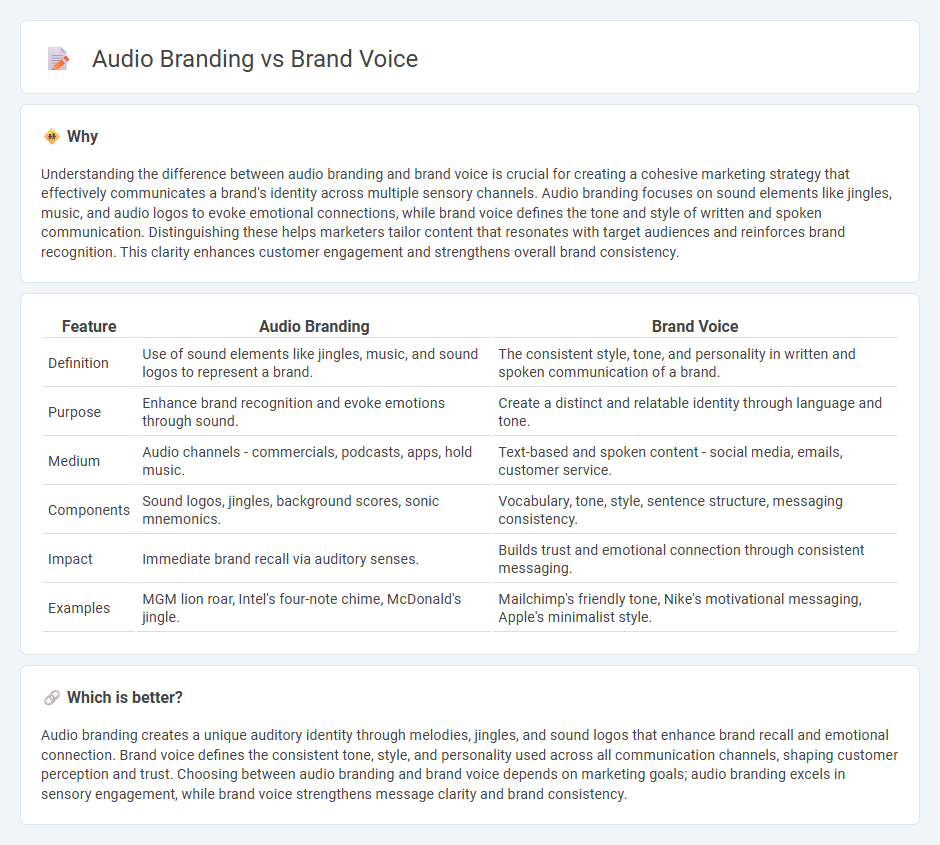
Audio branding uses sounds, music, and jingles to create an emotional connection that enhances brand recall through auditory identity. Brand voice defines the consistent tone, style, and personality conveyed in all communications to establish a recognizable and relatable brand image. Explore the distinct impacts of audio branding and brand voice to elevate your marketing strategy.
Why it is important
Understanding the difference between audio branding and brand voice is crucial for creating a cohesive marketing strategy that effectively communicates a brand's identity across multiple sensory channels. Audio branding focuses on sound elements like jingles, music, and audio logos to evoke emotional connections, while brand voice defines the tone and style of written and spoken communication. Distinguishing these helps marketers tailor content that resonates with target audiences and reinforces brand recognition. This clarity enhances customer engagement and strengthens overall brand consistency.
Comparison Table
| Feature | Audio Branding | Brand Voice |
|---|---|---|
| Definition | Use of sound elements like jingles, music, and sound logos to represent a brand. | The consistent style, tone, and personality in written and spoken communication of a brand. |
| Purpose | Enhance brand recognition and evoke emotions through sound. | Create a distinct and relatable identity through language and tone. |
| Medium | Audio channels - commercials, podcasts, apps, hold music. | Text-based and spoken content - social media, emails, customer service. |
| Components | Sound logos, jingles, background scores, sonic mnemonics. | Vocabulary, tone, style, sentence structure, messaging consistency. |
| Impact | Immediate brand recall via auditory senses. | Builds trust and emotional connection through consistent messaging. |
| Examples | MGM lion roar, Intel's four-note chime, McDonald's jingle. | Mailchimp's friendly tone, Nike's motivational messaging, Apple's minimalist style. |
Which is better?
Audio branding creates a unique auditory identity through melodies, jingles, and sound logos that enhance brand recall and emotional connection. Brand voice defines the consistent tone, style, and personality used across all communication channels, shaping customer perception and trust. Choosing between audio branding and brand voice depends on marketing goals; audio branding excels in sensory engagement, while brand voice strengthens message clarity and brand consistency.
Connection
Audio branding and brand voice are interconnected through the strategic use of sound elements that convey a brand's personality and values. Consistent audio branding, such as jingles, voiceovers, and sound logos, reinforces brand recognition and emotional connection by aligning auditory cues with the brand's tone and messaging. This synergy strengthens customer engagement and differentiates the brand in competitive markets.
Key Terms
Brand Voice, Audio Logo, Sonic Identity
Brand voice defines the consistent tone and style used in all communications, shaping how a brand's personality resonates with its audience across written and spoken content. An audio logo is a short, distinctive sound or jingle that instantly identifies a brand, enhancing recognition and recall in multimedia channels. Explore how mastering brand voice, audio logos, and sonic identity can elevate your brand's presence and engagement.
Personality
Brand voice defines a company's unique personality through language, tone, and style, shaping how audiences perceive its character and values. Audio branding leverages sound elements like jingles, voiceovers, and sonic logos to create an emotional connection and reinforce brand identity audibly. Explore how aligning brand voice and audio branding enhances overall brand recognition and customer engagement.
Sonic Identity
Sonic identity, a core component of audio branding, uniquely shapes how consumers perceive a brand through sound elements like jingles, voiceovers, and audio logos. While brand voice refers to the consistent tone and style of verbal communication across platforms, sonic identity leverages auditory cues to enhance brand recognition and emotional connection. Explore how integrating sonic identity can elevate your brand's presence and customer experience.
Source and External Links
Brand Voice: What It Is And Why It Matters - Writesonic - Brand voice is the distinct personality and communication style that a business uses across all platforms, helping it cut through the competition, maintain content consistency, and emulate human connection in written content.
Brand Voice: What It Is, Why It Matters + Examples | Sprout Social - A brand voice is a unified approach to tone, style, and messaging curated to communicate your business's unique personality, build recognition, and nurture trusting relationships with your audience across all mediums.
Brand Voice vs. Tone vs. Personality - Frontify - Brand voice encompasses the specific words and language a brand uses, embodying its unique perspective and values, which helps differentiate the brand and create fully connected customers.
 dowidth.com
dowidth.com